In what will be the third new manager for Union Saint-Gilloise in the last three seasons, the German coach Alexander Blessin has been appointed as the new manager of the Belgian side, signing a two-year contract and replacing Karel Geraets, who leaves the Brussels side after almost guiding the club to their first Belgian First Division title since 1935.
Blessin has experience managing in Belgium after managing now-Challenger Pro League side Oostende from 2020 to 2022, guiding the club to a fifth-place finish and into the playoffs in the 2020/21 season. Now, the 50-year-old brings his high-pressing style of football back to the Belgian top flight, and after an ill-fated spell with Italian side Genoa, will hope to again challenge for the title with USG next season.
This tactical analysis of Blessin will look at his tactics from his previous stint in Belgium with Oostende, analysing a few tactical principles that USG fans can expect to see from their side next season.
Preferred formations and style of play
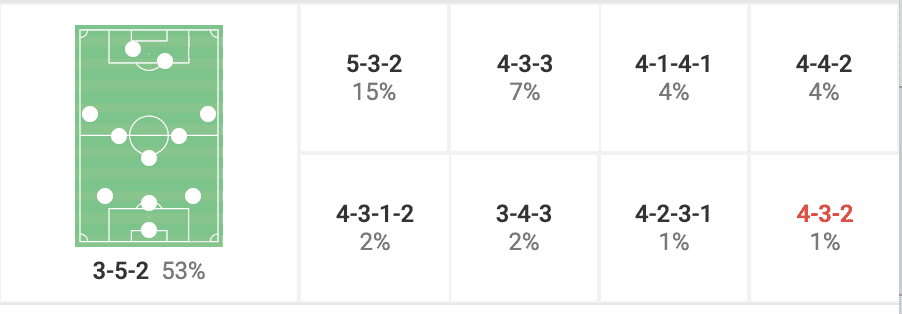
When it comes to a preferred formation for Alexander Blessin, the German likes to set his side up in a 3-5-2 formation, with it sometimes switching to a 5-3-2 in defensive moments. This back-three setup is something that the Union Saint-Gilloise side is already familiar with, as Karel Geraets utilised this formation during his time in charge of the club last season.
When it comes to Blessin’s style of play, the 50-year-old was moulded in the Red Bull way of playing, with him spending eight years managing in the RB Leipzig youth setup with both the U17 and U19 sides. This style was incorporated by Blessin when he moved to Oostende in 2020, with the German backing an aggressive gegenpressing approach, with his side looking to suffocate the opposition when they gathered possession and looking to win it back rather quickly in advanced areas.
With Oostende, Blessin did not necessarily look for his side to control possession; they instead looked to quickly progress the ball forwards, with the #8 and the outside centre-backs being key contributors during phases of build-up play, which are two things that will be covered in detail later on in this tactical analysis.
Looking to press quickly with numbers
When it comes to the German’s style of play, what stands out right away is the aggressive counterpressing, or gegenpressing, that Blessin implements into his sides. As previously mentioned, Blessin came through the Red Bull coaching model, a style heavy on counterpressing aggressively to win back possession.
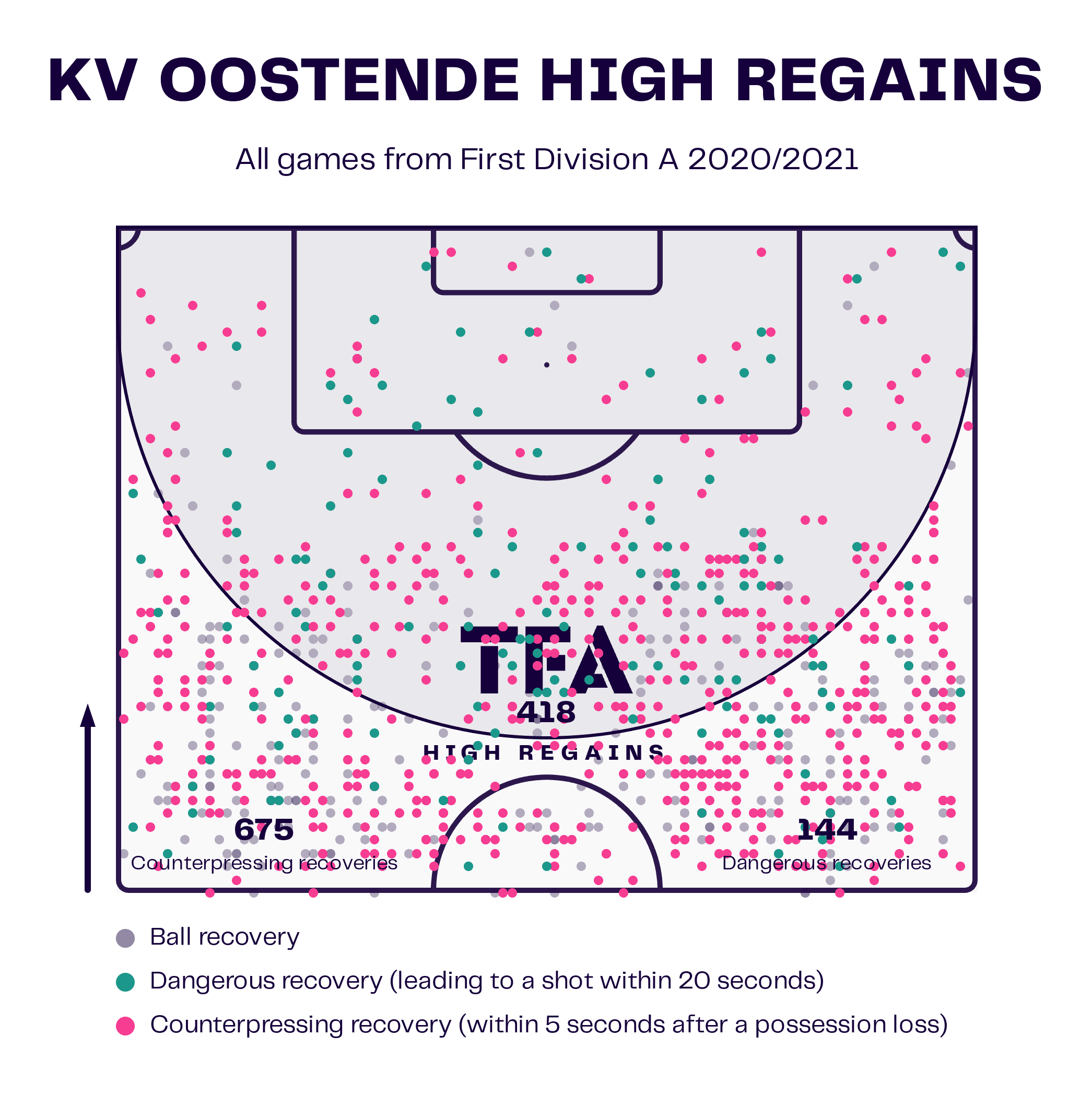
The image above shows the high regains of Oostende during the 2020/21 Belgian Pro League under Alexander Blessin. As the data viz graphic illustrates, during that great campaign under the German tactician, Oostende finished with 675 counterpressing recoveries, by far the highest number in the Belgian Pro League. They also finished the campaign with 418 high regains and 144 dangerous recoveries, highlighting how often Blessin looks for his sides to counterpress after losing possession.
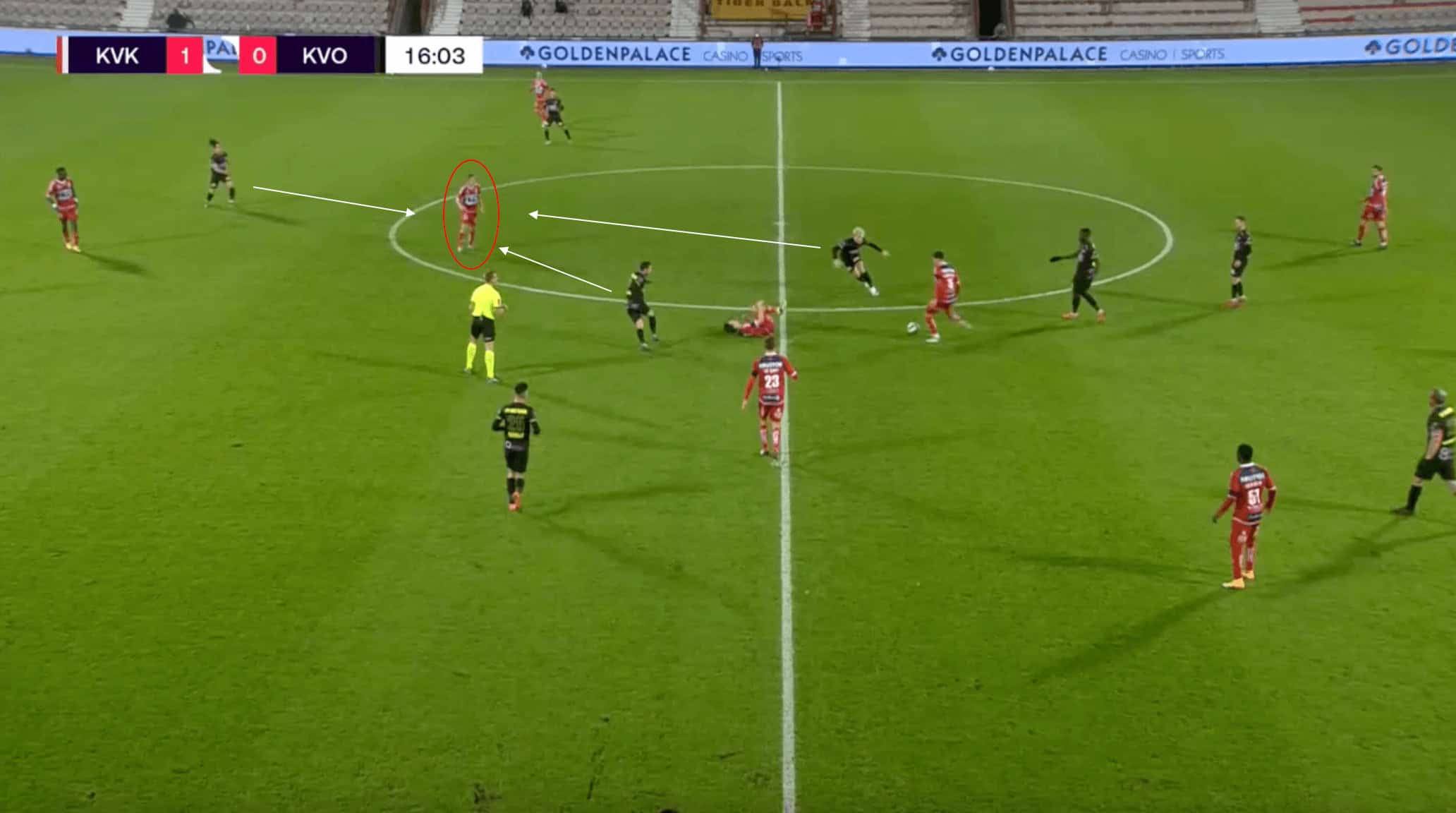
The image above shows an example of this aggressive counterpressing during Blessin’s time in charge of Oostende. In this phase of play above against Kortrijk, Oostende have just turned possession over near the centre circle and now look to counterpress. The Kortrijk player circled is the intended target of the pass, with him picking up a space between the Oostende lines.
As the ball is played towards him, the three closest Oostende players all converge on him, looking to regain possession quickly. This aggressive style of gegenpressing that Alexander Blessin uses does come with its risks, with the potential of opponents being able to play through the press and create clear-cut chances on goal.
This could have potentially happened in the phase of play above, with the central defender leaving his position to step up into midfield and engage the ball receiver. However, the German tactician’s pressing style leaves opposition sides with little time to assess potential passing options to continue progressing the ball forward.

The image above shows another example of the gegenpressing that the German manager looks for from his side after losing possession. In the phase of play above against Gent, the wing-back for the Belgian side has just received possession on the near touchline.
As the ball is travelling to him, the three Oostende defenders nearby all look to engage the player, angling their movements to eliminate any progressive passing angles and closing down with ruthless efficiency. As a result, Oostende are able to knock the ball out of play, allowing their defence to get back into shape and preventing Gent from progressing the ball forward.
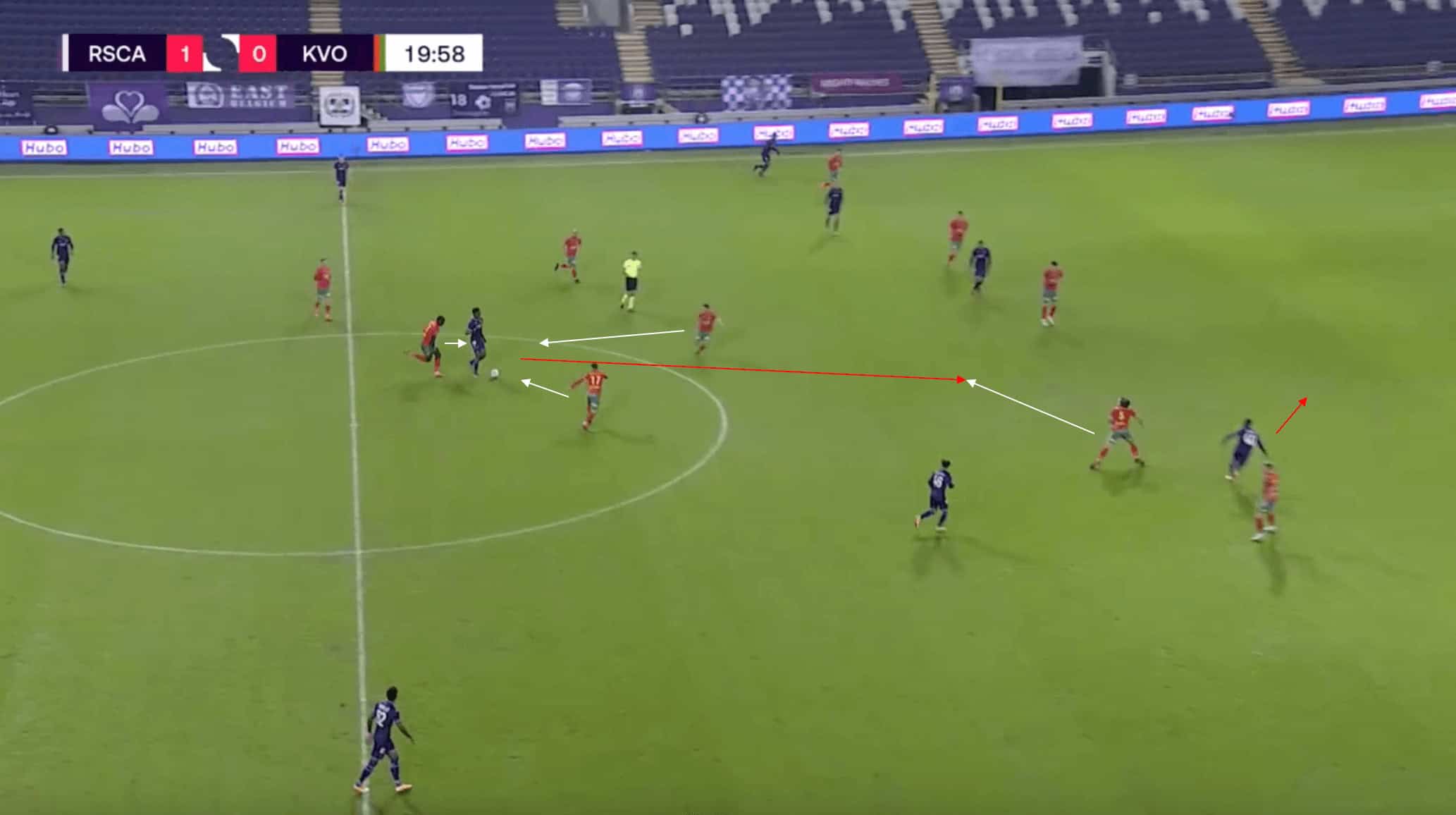
The image above again shows Alexander Blessin’s counterpressing style, with it looking to force the opposition into poor decisions if his side cannot quickly recover possession. In this phase of play above against Anderlecht, the midfielder can progress the ball past midfield, with the press of the three surrounding Oostende players forcing him into a quick decision.
Instead of being dispossessed, he attempts a pass to the forward, who is making a run in behind the Oostende defence. However, he doesn’t spot the centre-back, who recognises where the ball is looking to be played to and steps out into the space. As a result, he intercepts the pass and allows Oostende to begin an attacking phase of play.
As this section has illustrated, Alexander Blessin will bring a high-octane counterpressing style to Union Saint-Gilloise. This is a trademark of the 50-year-old German’s style of play, so look for the Belgian side to be very aggressive when they lose possession in the midfield areas next season.
Role of the centre-backs and defensive midfielder in build-up phases
As was mentioned earlier in this tactical analysis, Alexander Blessin sets his sides up in a 3-5-2 formation, with the central defenders and the defensive midfielder becoming crucial pieces to how the German wants his side to build play up from the back. This section will analyse these principles in more detail.
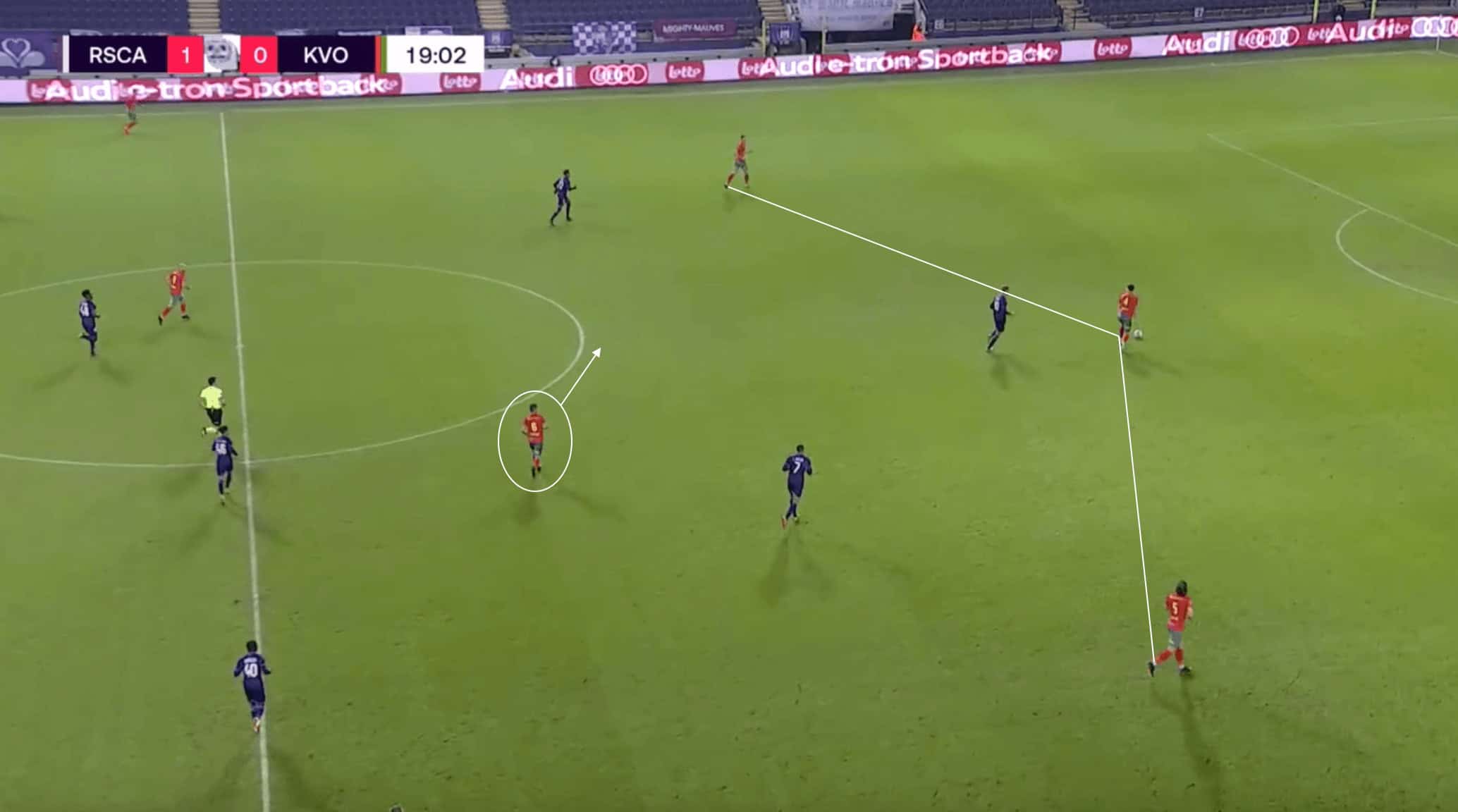
The image above shows the typical shape of Oostende’s backline under Alexander Blessin. As we can see from this phase of play against Anderlecht, the outside central defenders look to position wider, allowing them to potentially stretch the opposition’s press and attempt to open up spaces in the central areas. This is then where the role of the defensive midfielder becomes crucial for Blessin when his side looks to progress the play forward.
The positioning of the defensive midfielder in a deeper lying position close to the back three allows the ball to be played between the lines of the opposition’s press. It gives his side a numerical advantage in these spaces. As the Anderlecht forwards in this scenario are looking to man mark the centre-backs and prevent the ball from being circulated wide, the central option of the deeper-lying defensive midfielder becomes the best option to progress the ball forward and get past the opposition’s press.
This is how the role of the defensive midfielder under Alexander Blessin is two-fold, with the deeper positioning allowing them to create numerical advantages against the opposition’s attackers and keep their press slightly deeper, as well as be able to be the link to enable the centre-backs to get past the opposition press and progress the ball forward into the attacking areas of the pitch.
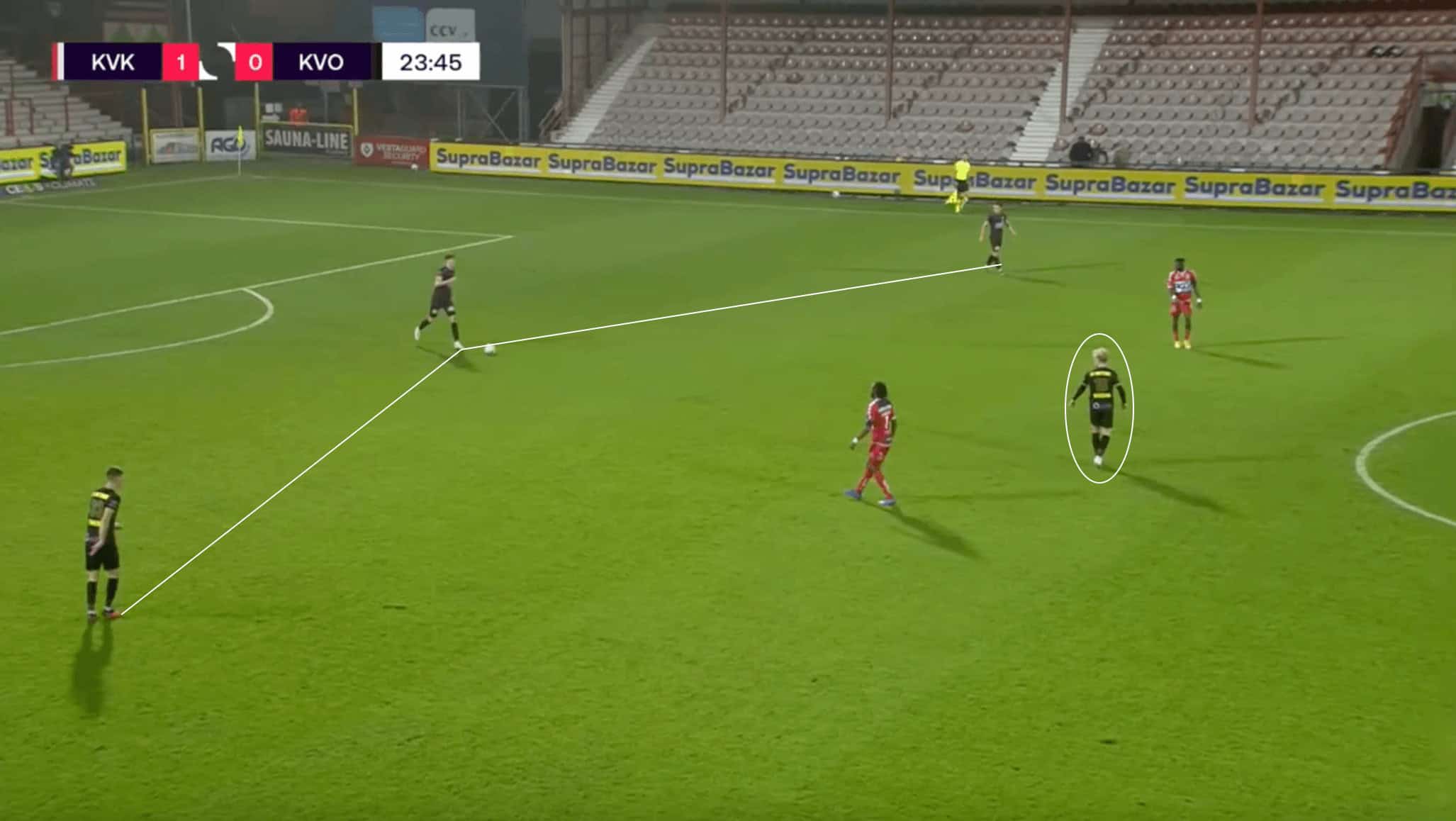
The image above shows another example of this shape: the outside centre-backs and the defensive midfielder looking to create space to progress the ball forward. In this phase of play above against Kortrijk, former Celtic and current Club Brugge player Jack Hendry is in possession and playing as the central player in the back three.
The two outside central defenders again operate in much wider positions, using their width to hopefully stretch the opposition’s front line and create space centrally. However, in this example, both opposition forwards are marking out former Chelsea youth player Cameron McGeehan, which prevents him from receiving possession to progress the ball into the attack.
As a result, Hendry plays the ball to his right and into the feet of the outside centre-back, who is positioned wide towards the near touchline. Given that he has the space with Kortrijk only committing the two forwards, he can drive forward and get towards the halfway line before sending a ball over the top, looking for the forwards positioned near the opposition’s penalty box.
In this scenario, the central route is blocked. However, due to the width that the centre-backs look to hold, Blessin’s side can still progress the ball without just sending it long from their defensive half or using a sole strategy of looking to create space to pick out the defensive midfielder.
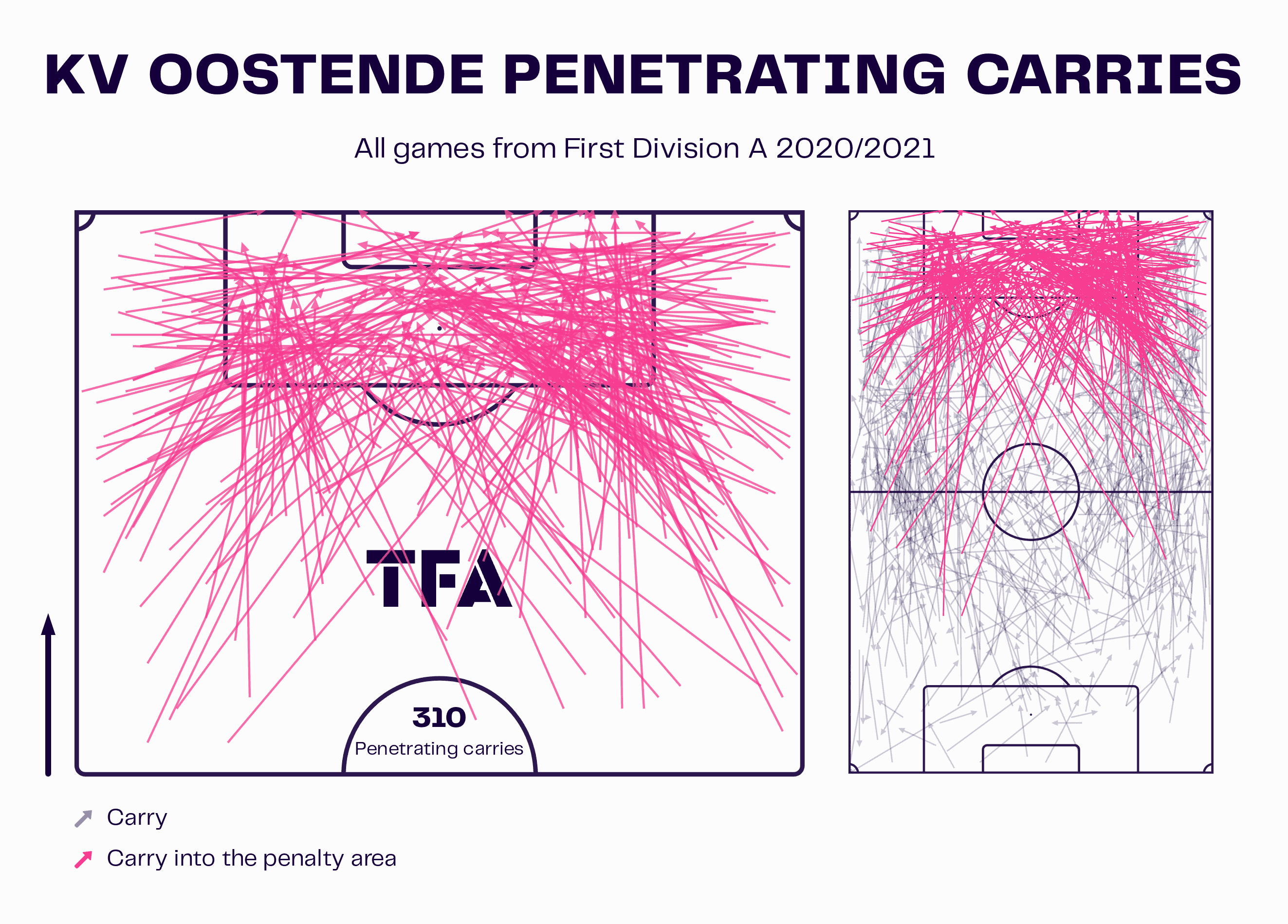
The data viz graphic above shows the penetrating carries that Oostende had in the 2020/21 Belgian Pro League season, with the main point of focus being the graph on the right. The pitch map shows the penetrating carries in all areas of the pitch for Blessin’s side in that campaign, and we can see that while it does not look like many, there are a decent number of penetrating carries from the Oostende backline.
The biggest concentration comes from the flanks, which again highlights the impact that the outside centre-backs play when Blessin’s sides look to build up play. The defensive midfielder dropping deeper also plays a crucial role in progressing the ball from the central areas, as the graphic also shows. All in all, this will be a tactic that you should keep an eye on from Union Saint-Gilloise come next season.
Conclusion
As this tactical analysis has shown, Union Saint-Gilloise have got a very capable, tactically astute manager in Alexander Blessin. After just missing out on the Belgian title last season, as well as being knocked out in the UEFA Europa League quarter-finals by former Real Madrid midfielder Xabi Alonso’s Bayer Leverkusen, the 50-year-old German is now tasked with attempting to take the club to the top both domestically and in European competitions.





Comments